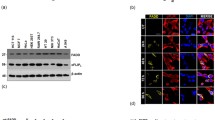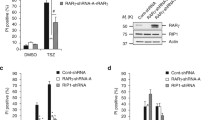Abstract
Proapoptotic nuclear receptor family member Nur77 translocates from the nucleus to the mitochondria, where it interacts with Bcl-2 to trigger apoptosis. Nur77 translocation is induced by certain apoptotic stimuli, including the synthetic retinoid-related 6-[3-(1-adamantyl)-4-hydroxyphenyl]-2-naphthalenecarboxylic acid (AHPN)/CD437 class. In this study, we investigated the molecular mechanism by which AHPN/CD437 analog (E)-4-[3-(1-adamantyl)-4-hydroxyphenyl]-3-chlorocinnamic acid (3-Cl-AHPC) induces Nur77 nuclear export. Our results demonstrate that 3-Cl-AHPC effectively activated Jun N-terminal kinase (JNK), which phosphorylates Nur77. Inhibition of JNK activation by a JNK inhibitor suppressed 3-Cl-AHPC-induced Nur77 nuclear export and apoptosis. In addition, several JNK upstream activators, including the phorbol ester TPA, anisomycin and MAPK kinase kinase-1 (MEKK1), phosphorylated Nur77 and induced its nuclear export. However, Nur77 phosphorylation by JNK, although essential, was not sufficient for inducing Nur77 nuclear export. Induction of Nur77 nuclear export by MEKK1 required a prolonged MEKK1 activation and was attenuated by Akt activation. Expression of constitutively active Akt prevented MEKK1-induced Nur77 nuclear export. Conversely, transfection of dominant-negative Akt or treatment with a phosphatidylinositol 3-kinase (PI3-K) inhibitor accelerated MEKK1-induced Nur77 nuclear export. Furthermore, mutation of an Akt phosphorylation residue Ser351 in Nur77 abolished the effect of Akt or the PI3-K inhibitor. Together, our results demonstrate that both activation of JNK and inhibition of Akt play a role in translocation of Nur77 from the nucleus to the cytoplasm.








Similar content being viewed by others
References
Adachi H, Preston G, Harvat B, Dawson MI, Jetten AM . (1998). Am J Respir Cell Mol Biol 18: 323–333.
Agadir A, Chen G, Bost F, Li Y, Mercola D, Zhang X . (1999). J Biol Chem 274: 29779–29785.
Bain J, McLauchlan H, Elliott M, Cohen P . (2003). Biochem J 371: 199–204.
Baker KD, Shewchuk LM, Kozlova T, Makishima M, Hassell A, Wisely B et al. (2003). Cell 113: 731–742.
Boisvieux-Ulrich E, Sourdeval M, Marano F . (2005). Exp Cell Res 307: 76–90.
Cao X, Liu W, Lin F, Li H, Kolluri SK, Lin B et al. (2004). Mol Cell Biol 24: 9705–9725.
Chang C, Kokontis J, Liao SS, Chang Y . (1989). J Steroid Biochem 34: 391–395.
Datta SR, Brunet A, Greenberg ME . (1999). Genes Dev 13: 2905–2927.
Davis IJ, Hazel TG, Chen RH, Blenis J, Lau LF . (1993). Mol Endocrinol 7: 953–964.
Dawson MI, Chao WR, Hobbs PD, Zhang XK . (1998). Cancer Lett 133: 1–8.
Dawson MI, Hobbs PD, Peterson VJ, Leid M, Lange CW, Feng KC et al. (2001). Cancer Res 61: 4723–4730.
Fahrner TJ, Carroll SL, Milbrandt J . (1990). Mol Cell Biol 10: 6454–6459.
Farhana L, Dawson MI, Huang Y, Zhang Y, Rishi AK, Reddy KB et al. (2004). Oncogene 23: 1874–1884.
Flaig R, Greschik H, Peluso-Iltis C, Moras D . (2005). J Biol Chem 280: 19250–19258.
Forman BM, Umesono K, Chen J, Evans RM . (1995). Cell 81: 541–550.
Frodin M, Gammeltoft S . (1999). Mol Cell Endocrinol 151: 65–77.
Garattini E, Parrella E, Diomede L, Gianni M, Kalac Y, Merlini L et al. (2004). Blood 103: 194–207.
Gianni M, de The H . (1999). Leukemia 13: 739–749.
Hazel TG, Misra R, Davis IJ, Greenberg ME, Lau LF . (1991). Mol Cell Biol 11: 3239–3246.
Hazel TG, Nathans D, Lau LF . (1988). Proc Natl Acad Sci USA 85: 8444–8448.
Hirata Y, Kiuchi K, Chen HC, Milbrandt J, Guroff G . (1993). J Biol Chem 268: 24808–24812.
Holmes WF, Soprano DR, Soprano KJ . (2002). J Biol Chem 277: 45408–45419.
Holmes WF, Soprano DR, Soprano KJ . (2003). J Cell Biochem 89: 262–278.
Hsu CA, Rishi AK, Su-Li X, Gerald TM, Dawson MI, Schiffer C et al. (1997a). Blood 89: 4470–4479.
Hsu CK, Rishi AK, Li XS, Dawson MI, Reichert U, Shroot B et al. (1997b). Exp Cell Res 232: 17–24.
Hunter T, Karin M . (1992). Cell 70: 375–387.
Jacobs CM, Boldingh KA, Slagsvold HH, Thoresen GH, Paulsen RE . (2004). J Biol Chem 279: 50097–50101.
Jeong JH, Park JS, Moon B, Kim MC, Kim JK, Lee S et al. (2003). Ann NY Acad Sci 1010: 171–177.
Kanda H, Miura M . (2004). J Biochem (Tokyo) 136: 1–6.
Katagiri Y, Takeda K, Yu ZX, Ferrans VJ, Ozato K, Guroff G . (2000). Nat Cell Biol 2: 435–440.
Kolluri SK, Cao X, Bruey-Sedano N, Lin B, Lin F, Han Y et al. (2003). Mol Cell Biol 23: 8651–8667.
Labelle Y, Bussieres J, Courjal F, Goldring MB . (1999). Oncogene 18: 3303–3308.
Labelle Y, Zucman J, Stenman G, Kindblom LG, Knight J, Turc-Carel C et al. (1995). Hum Mol Genet 4: 2219–2226.
Langdon SP, Rabiasz GJ, Ritchie AA, Reichert U, Buchan P, Miller WR et al. (1998). Cancer Chemother Pharmacol 42: 429–432.
Lee JM, Lee KH, Weidner M, Osborne BA, Hayward SD . (2002). Proc Natl Acad Sci USA 99: 11878–11883.
Lee KW, Ma L, Yan X, Liu B, Zhang XK, Cohen P . (2005). J Biol Chem 280: 16942–16948.
Li H, Kolluri SK, Gu J, Dawson MI, Cao X, Hobbs PD et al. (2000). Science 289: 1159–1164.
Li XS, Rishi AK, Shao ZM, Dawson MI, Jong L, Shroot B et al. (1996). Cancer Res 56: 5055–5062.
Li Y, Lin B, Agadir A, Liu R, Dawson MI, Reed JC et al. (1998). Mol Cell Biol 18: 4719–4731.
Liang JY, Fontana JA, Rao JN, Ordonez JV, Dawson MI, Shroot B et al. (1999). Prostate 38: 228–236.
Lin A, Dibling B . (2002). Aging Cell 1: 112–116.
Lin B, Kolluri S, Lin F, Liu W, Han YH, Cao X et al. (2004). Cell 116: 527–540.
Liu S, Wu Q, Ye XF, Cai JH, Huang ZW, Su WJ . (2002). World J Gastroenterol 8: 446–450.
Liu ZG, Smith SW, McLaughlin KA, Schwartz LM, Osborne BA . (1994). Nature 367: 281–284.
Masuyama N, Oishi K, Mori Y, Ueno T, Takahama Y, Gotoh Y . (2001). J Biol Chem 276: 32799–32805.
Milbrandt J . (1988). Neuron 1: 183–188.
Minden A, Karin M . (1997). Biochim Biophys Acta 1333: F85–F104.
Minden A, Lin A, McMahon M, Lange-Carter C, Derijard B, Davis RJ et al. (1994). Science 266: 1719–1723.
Oridate N, Higuchi M, Suzuki S, Shroot B, Hong WK, Lotan R . (1997). Int J Cancer 70: 484–487.
Pekarsky Y, Hallas C, Palamarchuk A, Koval A, Bullrich F, Hirata Y et al. (2001). Proc Natl Acad Sci USA 98: 3690–3694.
Perlmann T, Jansson L . (1995). Genes Dev 9: 769–782.
Philips A, Lesage S, Gingras R, Maira MH, Gauthier Y, Hugo P et al. (1997). Mol Cell Biol 17: 5946–5951.
Ramaswamy S, Ross KN, Lander ES, Golub TR . (2003). Nat Genet 33: 49–54.
Schadendorf D, Worm M, Jurgovsky K, Dippel E, Reichert U, Czarnetzki BM . (1995). Recent Results Cancer Res 139: 183–193.
Shao ZM, Dawson MI, Li XS, Rishi AK, Sheikh MS, Han QX et al. (1995). Oncogene 11: 493–504.
Shipp MA, Ross KN, Tamayo P, Weng AP, Kutok JL, Aguiar RC et al. (2002). Nat Med 8: 68–74.
Sun SY, Yue P, Wu GS, El-Deiry WS, Shroot B, Hong WK et al. (1999). Oncogene 18: 2357–2365.
Tournier C, Hess P, Yang DD, Xu J, Turner TK, Nimnual A et al. (2000). Science 288: 870–874.
Uemura H, Chang C . (1998). Endocrinology 139: 2329–2334.
Wan X, Duncan MD, Nass P, Harmon JW . (2001). Anticancer Res 21: 2657–2663.
Wang Z, Benoit G, Liu J, Prasad S, Aarnisalo P, Liu X et al. (2003). Nature 423: 555–560.
Weih F, Ryseck RP, Chen L, Bravo R . (1996). Proc Natl Acad Sci USA 93: 5533–5538.
Widschwendter M, Daxenbichler G, Culig Z, Michel S, Zeimet AG, Mortl MG et al. (1997). Int J Cancer 71: 497–504.
Wilson AJ, Arango D, Mariadason JM, Heerdt BG, Augenlicht LH . (2003). Cancer Res 63: 5401–5407.
Wilson TE, Fahrner TJ, Johnston M, Milbrandt J . (1991). Science 252: 1296–1300.
Wingate AD, Campbell DG, Peggie M, Arthur JS . (2005). Biochem J Oct 13, Epub ahead of print.
Woronicz JD, Calnan B, Ngo V, Winoto A . (1994). Nature 367: 277–281.
Wu Q, Dawson MI, Zheng Y, Hobbs PD, Agadir A, Jong L et al. (1997a). Mol Cell Biol 17: 6598–6608.
Wu Q, Li Y, Liu R, Agadir A, Lee MO, Liu Y et al. (1997b). EMBO J 16: 1656–1669.
Wu Q, Liu S, Ye XF, Huang ZW, Su WJ . (2002). Carcinogenesis 23: 1583–1592.
Zhang XK . (2002). Endocr Relat Cancer 9: 87–102.
Zhang Y, Dawson MI, Ning Y, Polin L, Parchment RE, Corbett T et al. (2003). Blood 102: 3743–3752.
Zhang Y, Huang Y, Rishi AK, Sheikh MS, Shroot B, Reichert U et al. (1999). Exp Cell Res 247: 233–240.
Zheng C, Xiang J, Hunter T, Lin A . (1999). J Biol Chem 274: 28966–28971.
Acknowledgements
We thank L Frazer for preparation of the manuscript, Dr Steven Frisch for providing MEKK1 expression plasmids, Dr Dan Mercola for DN-JNK, Dr Thomas Mustelin for CA-Akt, and Dr Anning Lin for JNKK2-JNK1. This work is, in part, supported by grants to X-k Zhang, MI Dawson and JC Reed from the National Institutes of Health (CA87000, CA, GM60544, CA109345) and to X-k Zhang from the Susan G Komen Breast Cancer Foundation, the US Army Medical Research and Material Command, the California Tobacco-Related Diseases Research Program and the California Breast Cancer Research Program.
Author information
Authors and Affiliations
Corresponding author
Rights and permissions
About this article
Cite this article
Han, YH., Cao, X., Lin, B. et al. Regulation of Nur77 nuclear export by c-Jun N-terminal kinase and Akt. Oncogene 25, 2974–2986 (2006). https://doi.org/10.1038/sj.onc.1209358
Received:
Revised:
Accepted:
Published:
Issue Date:
DOI: https://doi.org/10.1038/sj.onc.1209358
- Springer Nature Limited
Keywords
This article is cited by
-
Liquiritin exhibits anti-acute lung injury activities through suppressing the JNK/Nur77/c-Jun pathway
Chinese Medicine (2023)
-
Nur77-activated lncRNA WFDC21P attenuates hepatocarcinogenesis via modulating glycolysis
Oncogene (2020)
-
Cytoplasmic location of NR4A1 in aggressive lymphomas is associated with a favourable cancer specific survival
Scientific Reports (2018)
-
Orphan nuclear receptor NR4A1 regulates transforming growth factor-β signaling and fibrosis
Nature Medicine (2015)
-
Hypoxia triggers a Nur77–β-catenin feed-forward loop to promote the invasive growth of colon cancer cells
British Journal of Cancer (2014)




